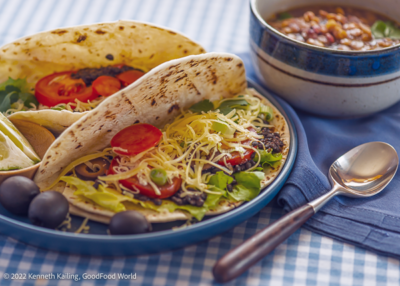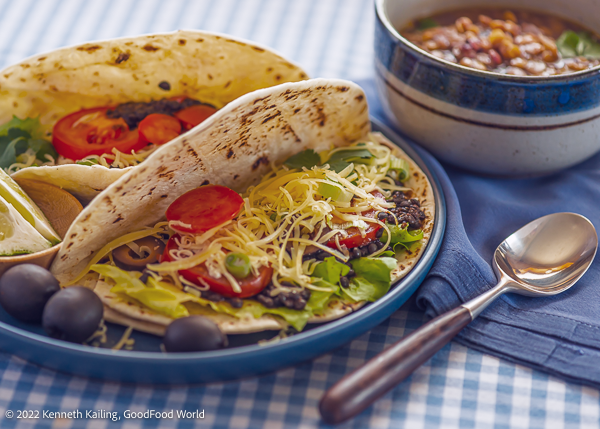
Lentils (those tiny little legumes often displayed in the “healthy grains” section of the supermarket) are not commonly on the dinner plate in most American households, even though they are a key element in the healthy - and highly recommended - Mediterranean diet.
Domesticated about 10,000 years ago along the eastern edge of the Mediterranean Sea, lentils provided an efficient form of protein for early man.
While lentils have been grown and eaten for millennia, they have been considered a “poor man’s food” for almost as long. Even in the beginning, the rich could get their protein from meat and the poor depended on plant protein.
And to further contribute to a poor reputation for lentils, the biblical story of Jacob and his brother Esau, revolves around the bartering of Esau’s birthright as oldest son for a lowly bowl of lentil stew (Genesis 29-34). It was described as a “red stew” and assumed to be a thick soup made of red lentils.
Today lentils are grown and consumed around the world and the US is one of the ten largest growers and one of the five largest exporters of the tiny legume. More than 70% of the lentils grown in the US - primarily in Montana, North Dakota, Washington and Idaho - are exported. At the same time, we import about 14% as much as we export. Montana is now the top state producing organic lentils.
Thousands of years after the first cultivation of lentils, many of the countries that were in the heart of lentil production originally are now the largest importers of lentils in the world.
Legume or Pulse?
The tiny lentil - Lens culinaris – is part of the large legume or bean family, Fabaceae, which includes plants that bear seeds in pods and range from trees and shrubs to small herbaceous plants like garden peas and sweet peas.
Is it a legume or a pulse? All Fabaceae plants are legumes, all pulses are legumes, but not all legumes are pulses. A pulse is the dry edible seed of a legume, edible by humans or livestock. The name pulse was taken from the Latin word puls, meaning a thick soup.
Pulses include dry beans, dry broad beans, dry peas, chickpeas, cow peas, pigeon peas, lentils, Bambara beans, vetches, lupins, but do not include high fat legumes like peanuts and soybeans.
The idea of rotating grains with pulse crops is one of the oldest concepts in agriculture. Middle Eastern farmers were alternately planting legumes and cereals as long as 6,000 years ago, and a three-field system of crop rotation became common practice in Europe beginning in the Middle Ages.[1]
Not only do pulses fix nitrogen in the soil to “feed” the following crops, they are becoming a good cash crop on their own.
Not All Lentils Are Equal
Lentils - like other assorted grains and beans - are on the shelves in every supermarket and in bulk bins in nearly every natural food market. But how to decide which ones you should buy?
Use this checklist and you'll make the right choice:
- Organic or Conventional? When selecting legumes, whole grains, or flour, we recommend you choose organic over conventional for a simple reason: organic production methods forbid the use of synthetic pesticides.By selecting organic you avoid consuming food products that may have been treated with any number of chemicals including Paraquat, Diquat, and Glyphosate. All three herbicides can be used late in the season[2], on standing lentil and grain crops for "pre-harvest desiccation... to accelerate or even up ripening to assist with harvest." Lentils may be harvested 2 to 7 days after application, depending on the type of herbicide used.
- Commodity or Family Farmed? Rarely are pulses labeled with information identifying the farm - or even the state - from which they originated. If possible buy from a farmer you know or buy brands that support small family farms. Commodity brands are generally labeled with the country of origin, though you may find a label that says, "US/Canada" or something similar.
- How Will You Use Them? "Decorticated" lentils, like petite crimson or small golden lentils, have had their dark skins removed leaving the bright cotyledon. They cook quickly and are often used to make purees, dips, and soups. Lentils with the skins on - black lentils, French green lentils, Spanish brown lentils, and common green/brown lentils - hold their shape when cooked and are good for chili, baked casseroles, veggie burgers, and hearty soups.
- How Old Are They? This question really applies to all the pulses in your pantry. If you've had them in a bag or jar for years and years, be advised that it will take you longer than you expect to cook them. While pulses keep well, it is best that you use them before more than a couple of years pass.
- When Do I Add the Salt? Now that you've selected the right lentil - and you know the seeds are fairly fresh - there are some cooking hints that will make your dishes taste even better.
- If you're not sure of the provenance of your lentils, be sure to rinse them carefully and check for stones and other foreign matter before cooking. Buy from brands you trust; high quality seeds have been cleaned and checked for foreign matter several times before packaging.
- Do not soak lentils before cooking.
- Bring the water to a boil, then add lentils and start your timing when you add them. Reduce the heat to low and slowly simmer.
- Cooking times are specific to the variety and processing of the lentils. Cooking time also varies with the age of the lentil; fresher lentils have more moisture and cook more quickly.
- DO NOT add salt to cooking water; salt toughens lentils as they cook. Salt when the lentils have cooked.
- Add a squeeze of lemon or a teaspoon of vinegar after cooking, but before draining. It will liven up the flavor.
- Try different varieties and experiment with flavors; each has its own subtle differences.
Resources
Cookbooks/References
Beans: A History, Ken Albala (Berg)
The Versatile Grain and the Elegant Bean, Sheryl and Mel London (Simon and Schuster)
Heirloom Beans, Steve Sando and Vanessa Barrington (Chronicle Books)
Grains, Rice, and Beans, Kevin Graham (Artisan)
Small-Scale Grain Raising - An Organic Guide to Growing, Processing, and Using Nutritious Whole Grains, Gene Logsdon (Chelsea Green)
Recipes
Jacob's Red Lentil Soup
Lentil Tacos
French Lentils With Roasted Red Peppers, Goat Feta, and Mint
Cooking Lentils? You're Doing It Wrong!
Ina's Unmeatloaf The Pulses of Life Sunny Crimson Dal
Order Online
Timeless Natural Food (also available in supermarkets and natural food stores across the US)
More Reading
[1]How pulse crops are saving Montana grain farmers
[2]Late Season Herbicide Use
Oasis in Aisle 6 - The Lifesaving Legumes

